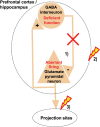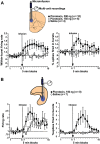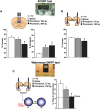Cognitive deficits caused by prefrontal cortical and hippocampal neural disinhibition
- PMID: 28477384
- PMCID: PMC5595754
- DOI: 10.1111/bph.13850
Cognitive deficits caused by prefrontal cortical and hippocampal neural disinhibition
Abstract
We review recent evidence concerning the significance of inhibitory GABA transmission and of neural disinhibition, that is, deficient GABA transmission, within the prefrontal cortex and the hippocampus, for clinically relevant cognitive functions. Both regions support important cognitive functions, including attention and memory, and their dysfunction has been implicated in cognitive deficits characterizing neuropsychiatric disorders. GABAergic inhibition shapes cortico-hippocampal neural activity, and, recently, prefrontal and hippocampal neural disinhibition has emerged as a pathophysiological feature of major neuropsychiatric disorders, especially schizophrenia and age-related cognitive decline. Regional neural disinhibition, disrupting spatio-temporal control of neural activity and causing aberrant drive of projections, may disrupt processing within the disinhibited region and efferent regions. Recent studies in rats showed that prefrontal and hippocampal neural disinhibition (by local GABA antagonist microinfusion) dysregulates burst firing, which has been associated with important aspects of neural information processing. Using translational tests of clinically relevant cognitive functions, these studies showed that prefrontal and hippocampal neural disinhibition disrupts regional cognitive functions (including prefrontal attention and hippocampal memory function). Moreover, hippocampal neural disinhibition disrupted attentional performance, which does not require the hippocampus but requires prefrontal-striatal circuits modulated by the hippocampus. However, some prefrontal and hippocampal functions (including inhibitory response control) are spared by regional disinhibition. We consider conceptual implications of these findings, regarding the distinct relationships of distinct cognitive functions to prefrontal and hippocampal GABA tone and neural activity. Moreover, the findings support the proposition that prefrontal and hippocampal neural disinhibition contributes to clinically relevant cognitive deficits, and we consider pharmacological strategies for ameliorating cognitive deficits by rebalancing disinhibition-induced aberrant neural activity. Linked Articles This article is part of a themed section on Pharmacology of Cognition: a Panacea for Neuropsychiatric Disease? To view the other articles in this section visit http://onlinelibrary.wiley.com/doi/10.1111/bph.v174.19/issuetoc.
© 2017 The British Pharmacological Society.
Figures




Similar articles
-
Hippocampal Neural Disinhibition Causes Attentional and Memory Deficits.Cereb Cortex. 2017 Sep 1;27(9):4447-4462. doi: 10.1093/cercor/bhw247. Cereb Cortex. 2017. PMID: 27550864
-
Frequency- and state-dependent effects of hippocampal neural disinhibition on hippocampal local field potential oscillations in anesthetized rats.Hippocampus. 2020 Oct;30(10):1021-1043. doi: 10.1002/hipo.23212. Epub 2020 May 12. Hippocampus. 2020. PMID: 32396678
-
Too little and too much: hypoactivation and disinhibition of medial prefrontal cortex cause attentional deficits.J Neurosci. 2014 Jun 4;34(23):7931-46. doi: 10.1523/JNEUROSCI.3450-13.2014. J Neurosci. 2014. PMID: 24899715 Free PMC article.
-
Prefrontal cortical gamma-aminobutyric acid transmission and cognitive function: drawing links to schizophrenia from preclinical research.Biol Psychiatry. 2015 Jun 1;77(11):929-39. doi: 10.1016/j.biopsych.2014.09.007. Epub 2014 Nov 18. Biol Psychiatry. 2015. PMID: 25442792 Review.
-
Impaired prefrontal inhibition in schizophrenia: relevance for cognitive dysfunction.Physiol Behav. 2002 Dec;77(4-5):501-5. doi: 10.1016/s0031-9384(02)00936-8. Physiol Behav. 2002. PMID: 12526990 Review.
Cited by
-
Alterations in brain structure and function associated with pediatric growth hormone deficiency: A multi-modal magnetic resonance imaging study.Front Neurosci. 2023 Jan 6;16:1043857. doi: 10.3389/fnins.2022.1043857. eCollection 2022. Front Neurosci. 2023. PMID: 36685242 Free PMC article.
-
Loss of dysbindin-1 affects GABAergic transmission in the PFC.Psychopharmacology (Berl). 2019 Nov;236(11):3291-3300. doi: 10.1007/s00213-019-05285-1. Epub 2019 Jun 14. Psychopharmacology (Berl). 2019. PMID: 31201475 Free PMC article.
-
Hippocampal deficits in neurodevelopmental disorders.Neurobiol Learn Mem. 2019 Nov;165:106945. doi: 10.1016/j.nlm.2018.10.001. Epub 2018 Oct 12. Neurobiol Learn Mem. 2019. PMID: 30321651 Free PMC article. Review.
-
A bibliometric analysis on the health behaviors related to mild cognitive impairment.Front Aging Neurosci. 2024 May 3;16:1402347. doi: 10.3389/fnagi.2024.1402347. eCollection 2024. Front Aging Neurosci. 2024. PMID: 38765772 Free PMC article.
-
GABA Supplementation Negatively Affects Cognitive Flexibility Independent of Tyrosine.J Clin Med. 2021 Apr 21;10(9):1807. doi: 10.3390/jcm10091807. J Clin Med. 2021. PMID: 33919136 Free PMC article.
References
-
- Anticevic A, Corlett PR, Cole MW, Savic A, Gancsos M, Tang Y et al. (2015). N‐methyl‐D‐aspartate receptor antagonist effects on prefrontal cortical connectivity better model early than chronic schizophrenia. Biol Psychiatry 77: 569–580. - PubMed
Publication types
MeSH terms
Substances
LinkOut - more resources
Full Text Sources
Other Literature Sources

